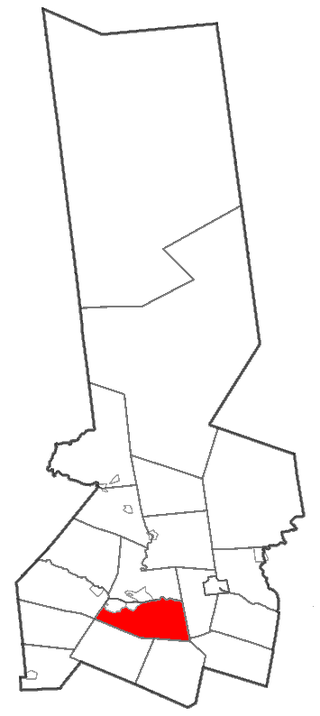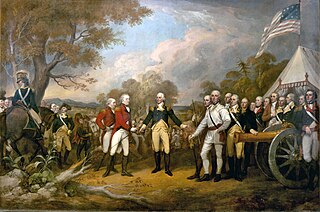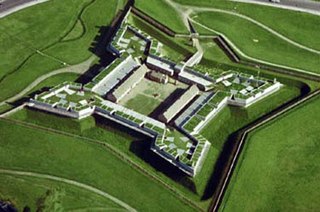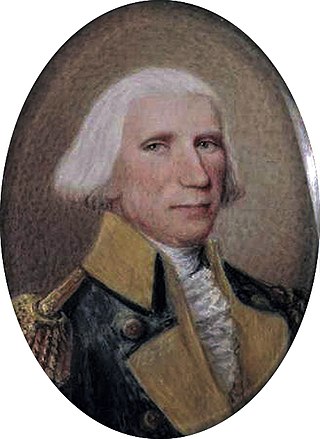
German Flatts is a town in Herkimer County, New York, United States. The population was 12,263 at the 2020 census down from 13,258 at the 2010 census.

The Saratoga campaign in 1777 was an attempt by the British high command for North America to gain military control of the strategically important Hudson River valley during the American Revolutionary War. It ended in the surrender of the British army, which historian Edmund Morgan argues, "was a great turning point of the war, because it won for Americans the foreign assistance which was the last element needed for victory."

Thayendanegea or Joseph Brant was a Mohawk military and political leader, based in present-day New York and, later, Brantford, in what is today Ontario, who was closely associated with Great Britain during and after the American Revolution. Perhaps the best known Native American of his generation, he met many of the most significant American and British people of the age, including both United States President George Washington and King George III of Great Britain.

Herkimer is a village on the north side of the Mohawk River and the county seat of Herkimer County, New York, United States, about 15 miles (24 km) southeast of Utica. As of the 2020 Census, it had a population of 7,234, and a predicted population of 7,283 on July 1, 2022. It was part of the Burnetsfield Patent and the first colonial settlement this far west in the Mohawk Valley.

Peter Gansevoort was a Colonel in the Continental Army during the American Revolutionary War. He is best known for leading the resistance to Barry St. Leger's Siege of Fort Stanwix in 1777. Gansevoort was also the maternal grandfather of Moby-Dick author Herman Melville.

The Battle of Oriskany was a major engagement of the Saratoga campaign during the American Revolutionary War. On August 6, 1777, an American column of Tryon County militia and Oneidas marching to relieve the siege of Fort Stanwix was ambushed by a contingent of Britain's Indigenous allies and Loyalists. It was one of the few battles of the war in which most non-Indigenous participants were settlers born in the Thirteen Colonies. The Americans suffered heavy casualties during the battle.

Brigadier-General Nicholas Herkimer was an American military officer who fought during the French and Indian War and Revolutionary War. He died in 1777 from wounds suffered during the Battle of Oriskany.

Fort Stanwix was a colonial fort whose construction commenced on August 26, 1758, under the direction of British General John Stanwix, at the location of present-day Rome, New York, but was not completed until about 1762. The bastion fort was built to guard a portage known as the Oneida Carry during the French and Indian War. Fort Stanwix National Monument, a reconstructed structure built by the National Park Service, now occupies the site.

Drums Along the Mohawk is a 1939 American historical drama film based upon a 1936 novel of the same name by American author Walter D. Edmonds. The film stars Henry Fonda and Claudette Colbert, was produced by Darryl F. Zanuck, and directed by John Ford.

Adam Frederick Helmer, also known as John Adam Frederick Helmer and Hans Adam Friedrich Helmer, was an American Revolutionary War soldier among those of the Mohawk Valley and surrounding regions of New York State. He was made nationally famous by Walter D. Edmonds' popular 1936 novel Drums Along the Mohawk with its depiction of "Adam Helmer's Run" of September 16, 1778, to warn the people of German Flatts of the approach of Joseph Brant and his company of Indians and Tories.

Elias Dayton was an American merchant and military officer who served as captain and colonel of the local militia and in 1783 rose to become a brigadier general during the American Revolutionary War. Afterward, he became the Mayor of Elizabethtown, New Jersey and served in the New Jersey General Assembly. He was the father of U.S. Constitution signer Jonathan Dayton.

Fort Herkimer was a colonial fort located on the south side of the Mohawk River, opposite the mouth of its tributary West Canada Creek, in German Flatts, New York, United States.

The King's Royal Regiment of New York, also known as Johnson's Royal Regiment of New York, King's Royal Regiment, King's Royal Yorkers, and Royal Greens, were one of the first Loyalist regiments, raised on June 19, 1776, in British Canada, during the American Revolutionary War.
Johannes Justus Schuyler was a Tory with patriot roots, who was used by American General Benedict Arnold to repel the British and Indian forces of Colonel Barry St. Leger and Joseph Brant from their siege of Fort Stanwix following the Battle of Oriskany during the American Revolution.

The northern theater of the American Revolutionary War after Saratoga consisted of a series of battles between American revolutionaries and British forces, from 1778 to 1782 during the American Revolutionary War. It is characterized by two primary areas of activity. The first set of activities was based around the British base of operations in New York City, where each side made probes and counterprobes against the other's positions that sometimes resulted in notable actions. The second was essentially a frontier war in Upstate New York and rural northern Pennsylvania that was largely fought by state militia companies and some Indian allies on the American side, and Loyalist companies supported by Indians, British Indian agents, and occasionally British regulars. The notable exception to significant Continental Army participation on the frontier was the 1779 Sullivan Expedition, in which General John Sullivan led an army expedition that drove the Iroquois out of New York. The warfare amongst the splinters of the Iroquois Six Nations were particularly brutal, turning much of the Indian population into refugees.
Fort Bull was located at the Oneida Carry in British North America during the French and Indian War.
The attack on German Flatts was the successful assault on the British North American settlement of German Flatts, New York by a combined French-Indian force on November 12, 1757 during the French and Indian War. Inhabited by Palatine colonists, the settlement's defenders were defeated by the 300-strong force of attackers, and German Flatts was captured and destroyed. Between 40 and 50 of the colonists were killed, and 150 were captured; in comparison, the French-Indian force only suffered 5 wounded.

The attack on German Flatts was a raid on the frontier settlement of German Flatts, New York during the American Revolutionary War. The attack was made by a mixed force of Loyalists and Iroquois under the overall command of Mohawk leader Joseph Brant, and resulted in the destruction of houses, barns, and crops, and the taking of livestock for the raiders' use. The settlers, warned by the heroic run of Adam Helmer, took refuge in local forts but were too militarily weak to stop the raiders.

The siege of Fort Stanwix began on August 2, 1777, and ended on August 22, 1777. Fort Stanwix, at the western end of the Mohawk River Valley, was a primary defense point for the Continental Army against the British and indigenous forces aligned against them during the American Revolutionary War. The fort was occupied by Continental Army forces from New York and Massachusetts under the command of Colonel Peter Gansevoort. The besieging force was composed of British regulars, Loyalist soldiers, Hessians, and indigenous warriors, under the command of Brigadier General Barry St. Leger. St. Leger's expedition was a diversion in support of Lieutenant General John Burgoyne's campaign to take control of the Hudson River Valley to the east.
Johan Jost Herkimer was a Loyalist born c. 1732, the second of five sons of Johan Jost Herkimer and Anna Catherine Petri of German Flatts, Province of New York. He was the younger brother of the American Patriot General Nicholas Herkimer.













